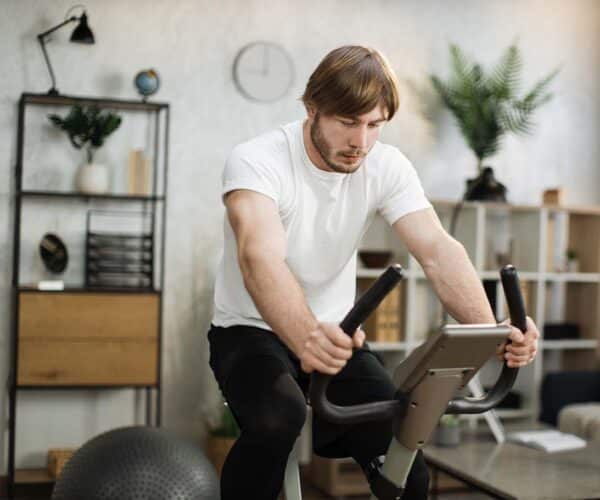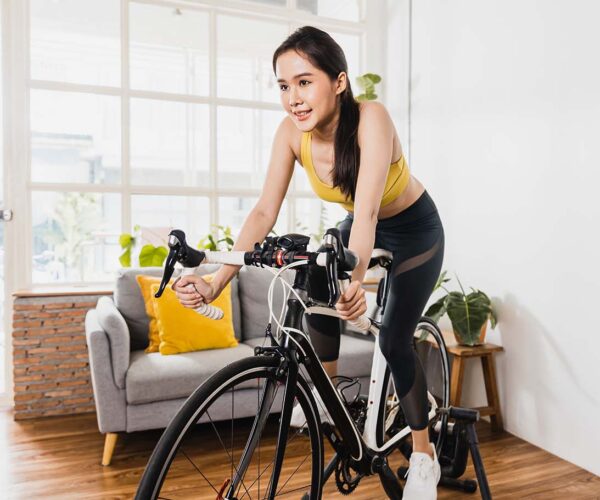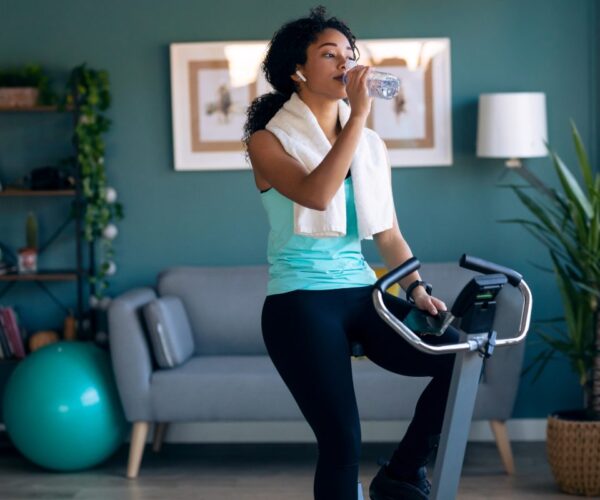As the evenings draw in and the weather takes a turn for the worse, it can be a real challenge for cyclists in the UK to keep their training consistent. Icy roads, relentless rain, and dark commutes make riding outdoors tricky — and sometimes downright dangerous.
That’s where indoor cycling comes in. Whether you’re training for next year’s events, keeping fit over the colder months, or simply looking for a safe way to ride, indoor options have never been better. In this blog, we’ll compare two of the most popular setups – exercise bikes and turbo trainers – and give you all the information you need to stay cycle-fit through the winter.
Why indoor cycling is a game-changer in Winter
Winter riding outdoors has its charms (a crisp morning ride on quiet lanes can be magical), but it often comes with hazards: icy patches, limited daylight, and the constant faff of cleaning your bike after every soggy spin.
Indoor cycling takes those barriers away. It offers:
- Consistency: no matter the weather, you can stick to your plan.
- Safety: no icy descents or traffic to contend with.
- Efficiency: hop on and ride, no layers of kit or bike cleaning required.
- Structured training: interval sessions are easier to manage when you’re not dealing with stop-start traffic.
For many UK riders, a reliable indoor setup can be the difference between starting spring with strong legs or feeling like you’re back at square one.
Exercise bike setups for home training

Exercise bikes are no longer just the dusty corner machines you’d find in an old-school gym. Today’s models are sleek, smart, and built with both fitness enthusiasts and serious cyclists in mind. There are several types worth knowing about:
Types of exercise bike
Smart bikes for cyclists
Models like the Wattbike Atom, Wahoo Kickr Bike, and Tacx Neo Bike are designed to replicate the feel of riding outdoors. They offer accurate power measurement, adjustable resistance, and full connectivity with platforms like Zwift and TrainerRoad.
Fitness-class bikes
Peloton, NordicTrack S22i, and similar models are geared towards riders who enjoy community-based training and live or on-demand classes, rather than data-driven interval sessions.
Hybrid/entry-level bikes
Brands such as JTX Fitness or ProForm offer solid, lower-cost machines ideal for those dipping their toes into indoor cycling without committing to premium models.
What the professionals say
Pro cyclists and coaches often recommend smart bikes like the Wattbike Atom or Kickr Bike because of their precision and adjustability. In fact, British Cycling has long used Wattbike in training environments for both elite and grassroots riders. Reviewers often praise the Kickr Bike for its incredibly realistic ride feel and adjustability, while Peloton is highlighted more for motivation and accessibility than for pure training metrics.
Newest features in the tech
- Auto-resistance: Bikes like the Kickr Bike adjust resistance automatically to match climbs or workout profiles in Zwift.
- Virtual gearing: Change your “gears” digitally to mimic road setups.
- Adjustable fit: High-end bikes allow you to match your road bike’s geometry down to the millimetre.
- Integrated screens and apps: Peloton and NordicTrack excel here, giving you guided rides and interactive classes.
Fitness Tracking
Modern smart bikes often track:
- Power (watts)
- Cadence
- Heart rate (via Bluetooth/ANT+ pairing)
- Training zones (FTP-based metrics)
- Advanced metrics like pedal smoothness and left/right leg balance (Wattbike in particular).
Pros of exercise bikes
- Convenience: Always ready to ride — no faffing with bike setups.
- Durability: Built to withstand years of heavy, sweaty use.
- Advanced data: Especially from Wattbike and Kickr models.
- Quiet operation: Generally quieter than wheel-on turbos.
- Great for shared households: Anyone can hop on without needing bike adjustments (Peloton especially).
Cons
- Costly: Premium smart bikes often cost £2,000+.
- Less authentic riding sensation: Even the best can’t perfectly mimic your actual road bike.
- Space hungry: They’re heavy and not easy to move around.
- Limited versatility: Can’t double up as your outdoor bike like a turbo trainer does.
Best for: Riders who want an all-in-one solution with minimal fuss, or those who don’t want to risk their best road bike on a trainer.
Turbo trainer setups for your road bike indoors

Turbo trainers are the go-to choice for many UK cyclists, from club riders to pros. The beauty is that you can train on your own bike, which makes the transition between indoors and outdoors seamless.
Types of Turbo Trainer
Basic “dumb” trainers
Simple resistance trainers that don’t connect to apps. Great for budget riders, though they lack data feedback.
Wheel-on smart trainers
Affordable, compact, and app connected. Popular entry-level models include the Wahoo Kickr Snap and Tacx Flow Smart.
Direct-drive trainers
These replace your back wheel for quieter, more accurate training. Bestsellers include the Wahoo Kickr, Tacx Neo 2T, Elite Direto XR, and Saris H3.
Rollers
Old-school, free-riding rollers improve balance and pedalling technique. While less common now, some pros still swear by them.
What the professionals say
Most pro teams use high-end direct-drive smart trainers like the Wahoo Kickr or Tacx Neo for their reliability and precision. Reviews consistently praise the Tacx Neo for being virtually silent and offering “road feel” simulation (cobblestones, descents), while the Wahoo Kickr is seen as the benchmark for accuracy and compatibility.
Newest features in the tech
- Automatic resistance control: Smart trainers match virtual gradients in Zwift or adjust intensity during structured intervals.
- Road feel simulation: Tacx Neo models mimic cobbles, gravel, or wooden boards.
- Downhill drive: Simulates freewheeling on descents.
- Improved accuracy: Many now measure power within ±1%.
- Climb simulators: Add-ons like the Wahoo Kickr Climb tilt your bike to replicate hills.
Fitness Tracking
Smart turbos integrate seamlessly with training apps and typically measure:
- Power output
- Cadence
- Virtual speed and distance
- Training zones (via apps like TrainerRoad/Zwift)
- Heart rate when paired with a monitor.
Pros of Turbo Trainers
- Authenticity: Ride your own bike indoors, keeping bike fit consistent.
- Wide choice: Options for every budget.
- Highly interactive: Perfect with Zwift, TrainerRoad, and Rouvy.
- Storage-friendly: Many models fold away when not in use.
- Upgradeable: Start basic and progress to smart features.
Cons
- Bike wear: Tyre and drivetrain wear on wheel-on models.
- Noise levels: Wheel-on trainers can be noisy; direct-drive is quieter.
- Setup hassle: Requires mounting and sometimes swapping components (e.g. cassettes).
- Space needed: A bike + trainer + mat can dominate smaller flats.
Best for: Road cyclists, triathletes, and riders who want realistic training that translates directly to performance outdoors.
Exercise Bike vs. Turbo Trainer
Feature | Exercise Bike | Turbo Trainer |
Cost | High upfront, all-in-one | Wide range, from £150–£1,000+ |
Space | Bulky but self-contained | Needs bike + trainer space |
Realism | Good, but not “your bike” | Very realistic |
Noise | Generally quieter | Depends on trainer model |
Flexibility | Stays indoors only | Use same bike indoors/outdoors |
Best for | Fitness riders, plug-and-play | Road cyclists, racers, Zwift fans |
Building the perfect indoor cycling setup

Whether you go for an exercise bike or a turbo trainer, your indoor setup will only be as good as the environment you create around it. The right space and kit can turn a sweaty slog into a smooth, motivating experience — and it makes it much easier to keep riding consistently through the winter.
1. Must-haves
A strong fan: Indoor riding is deceptively hot. Even short rides can feel like a sauna without decent airflow. Position the fan in front of you or at a slight angle for maximum cooling.
A turbo mat or old yoga mat: Protects your floor from sweat and stops your trainer or bike from shifting around.
Sweat guard/top tube cover: Sweat is highly corrosive — protect your bike frame and components.
Hydration: Always have a couple of bottles within reach. You’ll sweat more indoors than you expect.
Device mount or stand: A laptop stand, TV, or even an old music stand can work for holding your screen if you’re using Zwift, TrainerRoad, or a spin class app.
2. Nice-to-haves
Rocker plates: Allow side-to-side movement, making the ride feel more natural and reducing saddle pressure.
Wireless headphones or a Bluetooth speaker: Drown out trainer noise and immerse yourself in a playlist, podcast, or in-game sounds.
Strength training kit: Keep resistance bands, kettlebells, or dumbbells nearby for quick off-bike circuits. Great for squeezing in a balanced workout.
Towel hooks or shelf: Keeping a towel close at hand is essential — you’ll need it.
3. Space savers & positioning
Not everyone has the luxury of a dedicated “pain cave.” Here’s how cyclists make it work:
Spare room or garage: Ideal for permanent setups, especially with a turbo trainer, since you can leave everything in place and ready to ride.
Living room corner: Popular for exercise bikes like Peloton, as they’re tidy, self-contained, and less intrusive than a full bike + trainer setup.
Bedroom setups: Surprisingly common with compact turbos; just remember noise and vibration can travel through floors in flats.
Fold-away trainers: Many direct-drive and wheel-on trainers fold up, making them easier to store under a desk, in a cupboard, or behind a sofa when not in use.
4. Living with your indoor cycling setup
Noise considerations: Even the quietest trainers or bikes make some hum. If you’re in a flat or terrace house, consider positioning over a rug or mat to dampen vibrations.
Convenience matters: The easier it is to hop on, the more likely you’ll ride. If you need to drag everything out of a cupboard and set it up each time, motivation drops quickly.
Ventilation: Garages and conservatories are popular because they’re cooler, but if you’re indoors, crack a window or position near an open door.
Ambience: Many riders like to make it motivational — think LED strip lights, posters of big climbs, or simply a clean, tidy space that feels inviting to ride in.
Training apps & virtual platforms
Indoor riding has exploded thanks to apps like:
- Zwift: virtual worlds, group rides, and races.
- TrainerRoad: data-driven, structured training plans.
- Rouvy: augmented reality with real road footage.
- The Sufferfest (Wahoo SYSTM): hard-hitting interval sessions.
- Peloton: instructor-led classes, more fitness-community focused.
These platforms make training more engaging, but subscriptions add up, so pick the one that matches your goals.
Extra Winter cycling tips
Riding indoors through the darker months isn’t just about hopping on the bike and turning the pedals. A few smart habits and complementary routines can make all the difference to your winter fitness and motivation.
Strength & Conditioning
Cyclists often overlook off-bike work, but winter is the perfect time to build strength. Core stability, glute activation, and upper body conditioning will all improve your power transfer and posture on the bike. Simple bodyweight routines, kettlebells, or resistance bands are enough to target the muscles cycling doesn’t hit. Plus, building strength now helps protect against injuries when mileage increases in spring.
Mindset & motivation
Indoor riding can feel repetitive, so variety is key:
- Mix structured interval workouts with longer endurance spins.
- Join virtual group rides or races on Zwift for social motivation.
- Set mini goals (like improving your FTP or completing a Zwift route).
- Create a motivating space — good lighting, music, or even a small TV can make a big difference.
Think of winter not as a chore but as a chance to improve without the stop-start nature of outdoor riding.
Spin Classes & community options
Not everyone thrives training alone at home. Spin classes or indoor cycling studios can provide a burst of energy and accountability, especially when motivation dips. Many gyms in the UK now offer high-intensity spin sessions or Wattbike classes. These classes won’t always mirror the structure of a cycling-specific training plan, but they’re a fantastic way to push yourself in a group environment and add variety to your weekly routine.
So, what’s your chosen setup for the Winter…
Whether you choose an exercise bike or a turbo trainer, the key is finding a setup that works for your space, budget, and cycling goals. For some, the simplicity of an exercise bike is perfect; for others, nothing beats the realism of training on their own road bike indoors.
Whichever route you go, indoor cycling is one of the best ways to stay fit, motivated, and ready for spring. So, set up your fan, pick your training app, and make this winter the one where your cycling takes a big step forward.
Get specialist cycling insurance from SportsCover Direct
SportsCover Direct’s cycling insurance has been designed to give protection for cycling in the UK or cycling abroad.
Our cycling travel insurance covers you abroad, whether you’re enjoying the sport for leisure or cycling competitively. It offers cover for medical costs, equipment, cancelled trips and more. If you already have travel insurance, our bolt-on allows you to add the protection you need for cycling. You can also opt for our sports accident insurance, which has been created to protect you while cycling in the UK.
Choose Sports Accident cover to protect against personal liability, equipment and injuries whilst in the UK.
Find out more and get an instant quote designed to suit you.
This blog has been created as general information and should not be taken as advice. Make sure you have the correct level of insurance for your requirements and always review policy documentation.